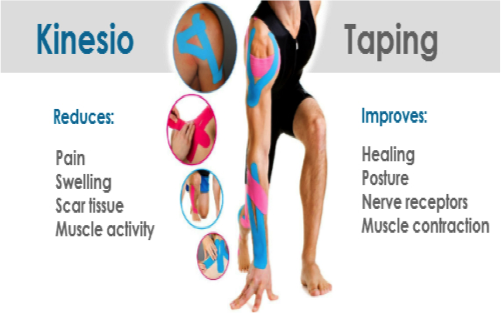Kinesiology Therapeutic Sports Tape has become popular among sports enthusiasts, runners and weight lifters. This strong, elastic tape is made of cloth, stretchy fibers and can be found in bright colors or more subdued, natural tones. While some may believe this tape is just a fad used by athletes in Cross Fit games or on the shins of marathon runners, it offers real benefits for anyone recovering from a muscle or tissue injury. When applied properly to a specific area, KT tape can relieve pressure on sensitive muscles, tissues and ligaments to relieve pain and promote healing.
History of KT Tape
Dr. Kenzo Kase, a Japanese chiropractor and acupuncturist, was searching for a therapy to allow patients to heal. He noted that sports tapes offered support, but were very stiff and didn’t allow a range of motion for patients. In the 1970’s, therapies were mainly limited to taping an area or immobilizing a joint or limb after an injury. Dr. Kase developed the tape to mimic human skin and replicate the elasticity of muscles, allowing for support and flexibility during the healing process.
How KT Tape Works
When an injury is present or a muscle is overused, it loses its elasticity. This creates tightness and tension in the muscle. When joints are misaligned, the surrounding tissues can become inflamed and swollen. By taping the affected area with varying degrees of tension, KT tape supports the affected area. This support relieves pressure and reduces the number of pain signals sent from the brain to the damaged region. Nerve endings lie near the surface of the skin. When the tape is applied, the skin is slightly lifted allowing better blood and lymph flow. Thus, when KT tape is applied properly, many painful conditions are relieved.
Where Can KT Tape Be Applied?
Honestly, KT tape can be used anywhere there is pain. Its effectiveness varies from condition to condition, but because it is a mild, non-invasive support, taping an area is certainly worth a try in the pursuit of pain relief. KT tape has been found particularly beneficial for some of the following conditions:
- Herniated discs in lumbar, thoracic or cervical regions
- Plantar fasciitis
- Shin splints
- Tendonitis
- Rotator Cuff Injuries
- Carpal Tunnel Syndrome
Chiropractic Adjustments and KT Tape
Your chiropractor should fully evaluate your condition by reviewing x-rays and developing a treatment plan to get you back to pain-free motion. KT tape is one tool that can help in this goal. After an adjustment, applying tape to a specific area, may help relieve pain as your treatment course progresses. Many videos available on YouTube demonstrate how to apply the tape based upon the area that is hurting. Your chiropractor may have specific application techniques and recommendations, as well.
Closing Thoughts from Dr. Tali
For patients looking for drug-free pain relief, KT tape can be extremely helpful. By supporting an injured area, while allowing flexibility and range of motion, patients are able to function during the healing process. Exercise routines, work and daily living should not be negatively impacted by annoying pain symptoms. Talk to your chiropractor about how best to use KT tape for your specific condition. At Radiant Health Chiropractic, we are happy to consult about this tool or other available supports to get you back to the life you deserve.




